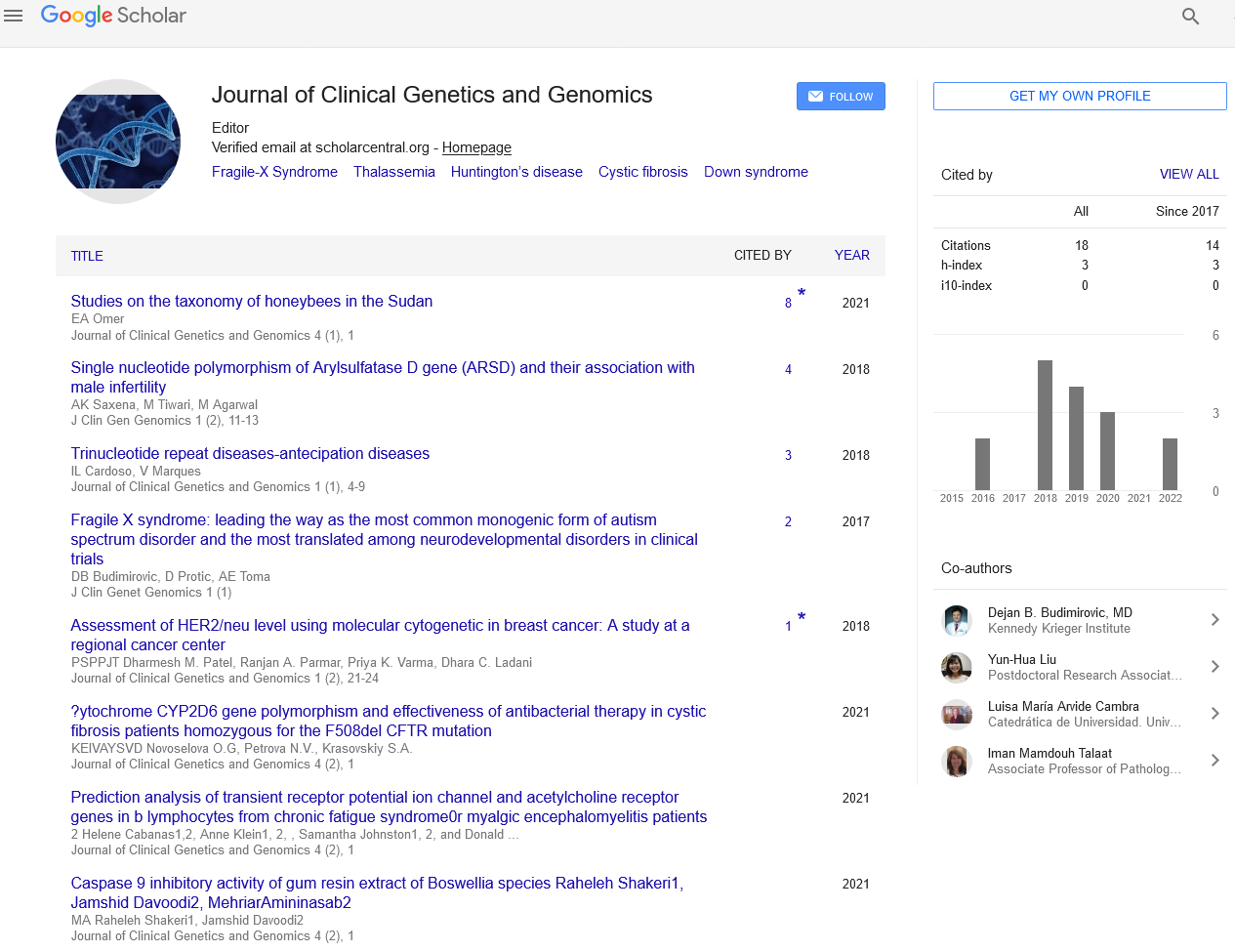Pipa carvalhoi and Xenopus tropicalis' karyotypes' evolutionary dynamics of repetitive DNA (Anura, Pipidae)
Received: 06-Apr-2022, Manuscript No. PULJCGG-22-5780; Editor assigned: 08-Apr-2022, Pre QC No. PULJCGG-22-5780 (PQ); Accepted Date: Apr 17, 2022; Reviewed: 12-Apr-2022 QC No. PULJCGG-22-5780 (Q); Revised: 15-Apr-2022, Manuscript No. PULJCGG-22-5780 (R); Published: 20-Apr-2022
Citation: Jones C. Pipa carvalhoi and Xenopus tropicalis' karyotypes' evolutionary dynamics of repetitive DNA (Anura, Pipidae). J. Clin. Genet. Genom. 2022;5(2):1-2.
This open-access article is distributed under the terms of the Creative Commons Attribution Non-Commercial License (CC BY-NC) (http://creativecommons.org/licenses/by-nc/4.0/), which permits reuse, distribution and reproduction of the article, provided that the original work is properly cited and the reuse is restricted to noncommercial purposes. For commercial reuse, contact reprints@pulsus.com
Abstract
Numerous repetitive DNA elements found in the huge frog genomes have contributed significantly to this vertebrate group's karyotypic diversity. The anurans in the family Pipidae are thought to have evolved mostly through intrachromosomal rearrangements based on their presumed primitive karyotype (2n=20). All other genera are located in Africa, with Pipa being the only South American pipid. At least 136 million years ago, the South American lineages split apart from the African ones, and it is believed that a significant biogeographic factor played a role in this process. Here, we explored the potential of repetitive DNA to enhance our comprehension of karyotype differentiation within the Pipidae family and to broaden our ability to decipher chromosomal evolution within this frog family. Our findings support hypotheses on the chromosomal homologies between the species in pairings 6, 8, and 9 by demonstrating a lengthy history of conservation in the chromosome containing the H3 histone locus. The chromosomal distribution of the microsatellite motifs also offers helpful markers for comparative genomics between Pipa carvalhoi and Xenopus tropicalis at the chromosome level, providing fresh perspectives on how the karyotypes of these species have evolved. We found patterns in the distribution and abundance of the microsatellite arrangements that were similar, reflecting the shared chromosomal organisation between these two species in the terminal/subterminal region. The longitudinal differentiation of pairs that are identical in size and form, such as pairs 1, 2, 4, and 5, was made possible by the microsatellite probes, which discovered a different arrangement of the repetitive DNA among the chromosomes of the two species. With a clear enrichment of the CA and GA microsatellite motifs in P. carvalhoi, we also discovered evidence of the different composition of the repeating motifs of the centromeric region between the species investigated in the current study. Last but not least, Interstitial Telomeric Sequences (ITS) and microsatellite enrichment in the pericentromeric region of chromosome pairs 6, 8, and 9 in the P. carvalhoi karyotype support the idea that pericentromeric inversions happened during the chromosomal evolution of P. carvalhoi and support the role of repetitive DNA in the remodelling of the karyotype architecture of the Pipida
Key Words
Karyotype; Microsatellite; Pericentromeric; Microsatellite; Pipida
Introduction
Amphibians are a rich and numerous group of vertebrates that serve as an essential evolutionary genetics model. Given that their genomes are rather vast and include a high amount of repetitive DNA, amphibian genomes are frequently used as examples of the Cvalue paradox phenomenon. The repetitive portion of the genome plays a crucial role in the stability of the chromosome, the cell cycle, and the regulation of gene expression, in addition to playing a structural role in the eukaryotic chromosome. It also serves as an important substrate for genome evolution. When it comes to chromosomal rearrangement events like deletions, duplications, inversions, and translocations that cause the significant karyotypic variation seen during the evolution of many groups of organisms, repetitive DNA sequences play a role either directly or indirectly.
The processes that lead to the evolution of repetitive DNA take place at an intragenomic level and are closely connected to how these repetitive sequences are arranged in chromosomes. The distributed DNA (transposable elements) and DNA sequences ordered in tandem, such as microsatellite, mini-satellite, and satellite DNA, are the two main categories of these repeating sequences. Chromosomal rearrangements, ectopic recombination, and genic conversion are all more likely to occur when satellite DNA, which includes micro- and minisatellites, is composed of systematic tandem repeats. A notable example of this are microsatellite repeats, which are composed of short (2–7 base) sequences with several repetitions. High rates of variation are seen in these sequences, which could be a part of either the heterochromatin or the euchromatin.
In contrast, the multigene families that encode basic molecules (such as histone genes, rDNAs, and non-codifying nuclear RNAs— snoRNAs) are under strong selective pressures and frequently preserve a conserved nucleotide sequence and chromosome position over the course of a lineage's evolutionary history. Because of this, these gene families serve as good chromosomal markers for research comparing how the genomes of other animals are organised. There is a lot of evidence that the chromosomal organisation of various repetitive DNA classes is conserved throughout the karyotype evolution of closely related species, and that studying this DNA may help us understand how these groups' chromosomes have evolved. This makes the Pipidae family of amphibians an intriguing group to study in terms of chromosomal evolution.
Hymenochirus, Pseudhymenochirus, Pipa, and Xenopus are the four genera that make up the family Pipidae, which has 41 species. The other genera are found throughout sub-Saharan Africa, while Pipa is only found in Central and South America. According to a recent phylogenetic reconstruction, the African taxa [(Xenopus + Silurana) + (Hymenochirus + Pseudhymenochirus)] are the sister group to Pipa. Due to conflicting fossil, morphological, and molecular evidence, the diversification of the African and South American lineages is still up for debate.





